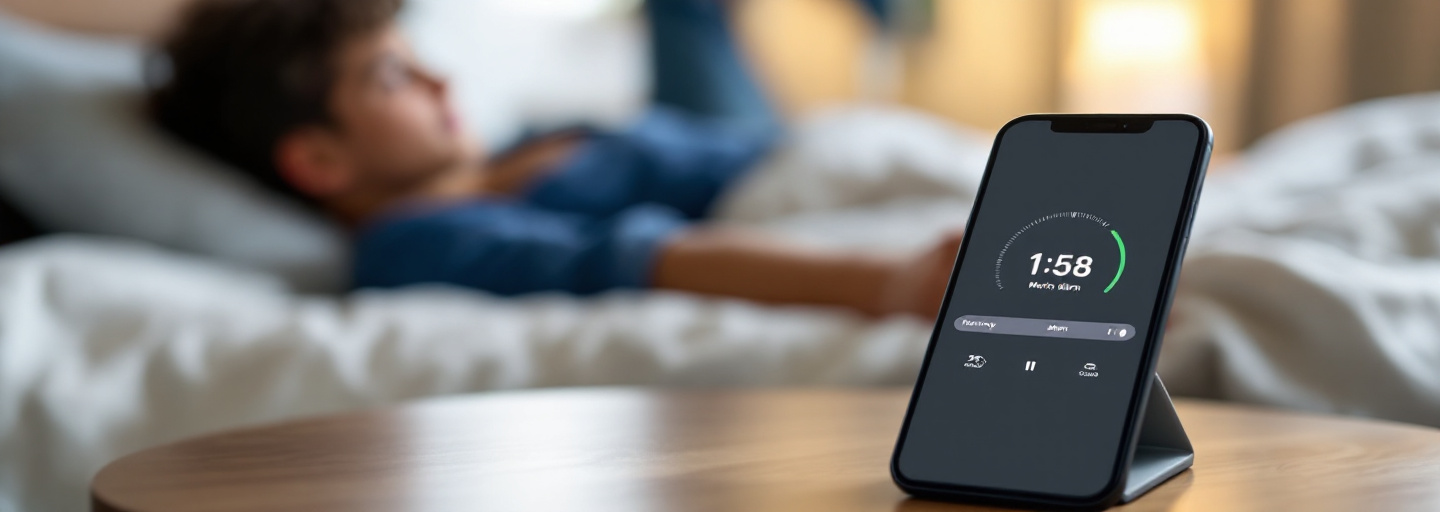5 Time Management Hacks for Students Using Online Alarms
« Back to all blog postsDiscover five effective time management hacks for students using online alarms to boost focus, structure study sessions, and improve productivity.

Students today juggle more responsibilities than ever before.
According to a recent study by the American Psychological Association, 45% of students report feeling overwhelmed by their workload, with time management being their biggest challenge.
While smartphones have made alarms more accessible than ever, most students aren’t using these tools to their full potential.
The right alarm strategy can transform a chaotic schedule into a productive routine.
Using Alarms to Structure Study Sessions
The average student loses nearly 30% of study time to distractions and interruptions. This wasted time adds up quickly, turning what should be productive study blocks into frustrating, inefficient sessions.
Setting specific alarms for dedicated study blocks creates psychological boundaries that help your brain resist distractions. When you hear that distinct tone signaling “study time,” your mind shifts into focus mode more readily than if you simply decide to start studying without this auditory cue.
Different alarm sounds can create powerful mental associations for different subjects. Your brain forms connections between specific tones and the type of thinking required. Try using classical music tones for literature or philosophy and sharper electronic sounds for math or science work.
You can experiment with our preset alarms to find sounds that work best for different subjects.
Spaced repetition alarms significantly improve retention compared to cramming. Set review alarms at strategic intervals: 24 hours after initial learning, then 3 days later, and again after one week. This schedule aligns with how our memory consolidates information and can boost retention by up to 70%.
Transition alarms prevent subject fatigue by signaling when to switch topics. After 50-60 minutes on a single subject, your brain’s ability to absorb new information diminishes. An alarm that prompts you to switch from calculus to history refreshes your mental energy and maintains productivity throughout longer study sessions.
These structured blocks create a rhythm that trains your brain to focus intensely during designated periods, making your study time management more effective and less dependent on willpower alone.
Setting Reminders for Breaks
Research consistently shows that the brain’s ability to maintain focus diminishes significantly after 45-50 minutes of continuous work. Without breaks, your productivity doesn’t just plateau—it actively declines.
Strategic breaks prevent these diminishing returns. They’re not a luxury but a necessity for effective time management for students. The optimal break schedule includes 5-10 minute pauses every 45-50 minutes of focused work.
Online alarms ensure you don’t skip these crucial recovery periods or accidentally extend them too long. Without a clear signal to start and end breaks, students often either work until exhaustion or let short breaks turn into hour-long distractions.
Break alarms work best when paired with specific recovery activities. Set your alarm to remind you to:
- Stand and stretch to release physical tension
- Drink water to maintain hydration
- Perform quick eye exercises to reduce screen fatigue
- Take 10 deep breaths to reset mental focus
For activities like stretching or quick exercises, you might find our circuit timer particularly useful for structuring short, effective breaks.
Customizing break alarm sounds with calming tones helps create a mental shift from work mode to relaxation mode. This sound differentiation signals your brain to temporarily disengage from problem-solving and enter a brief recovery state.
When your break alarm sounds, immediately stop working. When the end-of-break alarm rings, return to your task without negotiation. This discipline transforms breaks from potential distractions into powerful productivity tools.
Using Timers for Focus Techniques Like Pomodoro
What is the Pomodoro Technique?
The Pomodoro Technique uses a simple timer to break work into focused intervals, traditionally 25 minutes of work followed by 5-minute breaks. After four work periods, you take a longer 15-30 minute break.
This method works because it aligns with research on attention spans. Most people can maintain intense focus for about 25 minutes before needing a mental reset. The technique transforms time from an enemy into a predictable ally.
You can try this method immediately with our Pomodoro timer that’s specifically designed for this technique.
Customizing Pomodoro for Your Study Style
The standard 25/5 minute work/break cycle isn’t optimal for everyone. Some students focus better with 35/7 intervals, while others prefer 20/3 splits for intense subjects.
To find your ideal interval, start with the standard 25 minutes. If you consistently feel distracted before the timer rings, try shorter periods. If you’re still in deep focus when the alarm sounds, experiment with longer intervals.
Match your intervals to specific tasks. Use shorter cycles (15-20 minutes) for high-intensity work like memorization or complex problem-solving. Save longer intervals (30-40 minutes) for reading or note-taking that requires less mental strain.
Alternative Timer-Based Focus Methods
The 52/17 Method emerged from productivity research showing top performers often work intensely for about 52 minutes, then take decisive 17-minute breaks. This longer focus period works well for complex projects requiring deeper thought.
The 90-minute Ultradian Rhythm technique aligns with your body’s natural energy cycles. Work for 90 minutes, then take 20-30 minute breaks to match your brain’s natural ultradian rhythms of peak performance and recovery.
To implement any timer-based technique:
- Select your focus method based on task type and personal preference
- Set up your online timer with appropriate intervals
- Remove distractions before starting the timer
- Work exclusively on one task during the focus period
- Take complete breaks during rest periods (no checking emails or messages)
The key to success with any timer method isn’t just setting the alarm—it’s respecting it as a non-negotiable boundary for your attention.
Creating a Daily Routine with Alarms
Students with consistent daily routines score 15-20% higher on exams and report 40% lower stress levels than those with irregular schedules. Alarms create the structure that makes this consistency possible.
Morning alarms should create a sequence, not just a wake-up call. Set separate alarms for waking up, finishing breakfast, and starting your first study session. This sequence prevents morning drift where you lose valuable time to indecision.
Meal-time alarms prevent the common student pattern of skipping meals during intense study periods or stress-eating when overwhelmed. Regular nutrition directly impacts cognitive function and energy levels throughout the day.
Evening wind-down alarms signal when to stop studying and begin preparing for sleep. Students who study until the moment they fall asleep show significantly poorer information retention than those who allow a buffer period for their brain to process the day’s learning.
| Time | Alarm Purpose | Benefit |
|---|---|---|
| 7:00 AM | Wake up | Consistent wake time regulates sleep cycle |
| 7:30 AM | Finish breakfast | Ensures proper nutrition before study |
| 8:00 AM | Start first study block | Takes advantage of morning mental clarity |
| 12:00 PM | Lunch break | Prevents skipping meals during intense study |
| 5:00 PM | Exercise reminder | Promotes physical health and stress relief |
| 9:30 PM | Begin wind-down routine | Signals brain to prepare for sleep |
| 10:30 PM | Lights out | Ensures adequate sleep for next day |
This schedule represents a balanced approach for a typical college student with morning classes. Adjust times based on your class schedule and personal energy patterns.
Setting up recurring alarms for daily tasks builds habits through repetition and reduces decision fatigue. Setting your alarms is simple with our online alarm clock that lets you save and reuse your most important daily reminders.
The most effective routines acknowledge your natural energy patterns. Schedule difficult subjects during your peak alertness hours and save lighter work for when your energy naturally dips.
Maximizing Productivity with Custom Alarm Settings
Personalized reminder systems increase effectiveness by 40% compared to generic alerts. This customization transforms alarms from simple notifications into powerful productivity triggers.
Descriptive alarm labels create accountability and clarity. Compare the vague “Study” to the specific “Complete Physics Problem Set 3.4-3.8.” The detailed label eliminates ambiguity about what you should be doing when the alarm sounds.
Different alarm tones create an intuitive priority system for student productivity tips:
- Gentle sounds for routine tasks like daily reading
- Moderate tones for regular assignments
- Distinctive urgent sounds for approaching deadlines or important meetings
Whether you need a reminder for early morning study sessions or late-night review , having reliable alarms ensures you stay on schedule.
Syncing alarms across devices ensures you never miss important reminders when switching between laptop and mobile. This redundancy is especially important for critical deadlines or time-sensitive tasks.
In shared study spaces like libraries, vibration-only alarms prevent disrupting others while still keeping you on schedule. Position your phone or device where the vibration will be noticeable without creating noise.
Key customization options to consider:
- Descriptive labels that specify exact tasks
- Color coding for different subjects or priority levels
- Volume adjustments based on environment
- Strategic placement of devices when alarms are set
The most effective alarm systems grow with you. Review and adjust your alarm strategy monthly based on what’s working and what needs refinement. This ongoing optimization ensures your time management system evolves with your changing academic demands.

